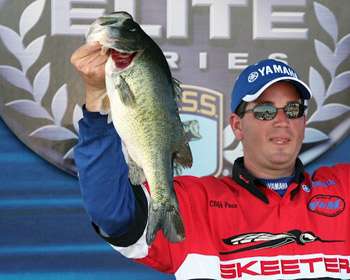
Up until a few years ago, pro angler Cliff Pace didn't even own a spinning rod. The Mississippi resident relied on tried-and-true "bubba" tactics to excel in tournaments. But once he started to compete against the best of the best in the Bassmaster Elite Series, he realized that he needed to integrate finesse tactics into his arsenal, and that called for spinning tackle.
He experimented with a number of rods until he found one that suited his needs and his fishing style. For each angler this will be a personalized quest, but one that's necessary to avoid losing fish. "The smaller the equipment is, the more the flaws are likely to show up," he says. "So it's really important to get a rod you like."
Once a spinning-challenged angler decides to take the leap, Pace says the best way to gain comfort with his equipment is to test it out on as many fish as possible. "The best thing to do is go to farm ponds," he explains. "I went to little bitty bodies of water where I could get dozens of bites an hour. I went there two or three times a week for several months and never picked up anything but spinning tackle. "You'd be surprised how many big fish you can catch on 6- or 8-pound-test line if you don't do anything dumb," he adds.
Modern reels have sophisticated and smooth drag systems that, used properly, allow a fish to tire itself out. "I've never figured out how to back-reel without tearing my fingers up. I rely on my drag system. The systems we have today are so good. They won't let you down." The rod he prefers was designed by fellow Elite Angler Jeff Kriet for Castaway Rods.
It has an action that cushions against the pull of the fish. "You don't want to use a rod that's very stiff when you get into the lower line sizes," he says. "Most of us are using fluorocarbon lines, so you don't have all the stretch you had years ago with monofilament. With line that doesn't stretch much, you have to use a rod that has some 'give.' That way, if you get a fish up by the boat and it surges, a good drag and flex in the rod will keep it from breaking off."
He put his money where his mouth is at a record setting 2007 Elite Series tournament on California's Clear Lake. While winner Steve Kennedy amassed his winning catch with heavy tackle and big swimbaits, both Pace and Kriet went with the light stuff to earn checks. In fact, every fish Pace weighed in over the three tournament days — 15 of them that averaged just a hair under 4 pounds, to be precise — came on spinning tackle. Why did he buck the conventional wisdom and, as they say, "go hunting for bears with a BB gun?"
"That's a big fish lake," he says. "I don't think people go there and finesse fish because they don't feel like they need to, but I picked up the spinning rod in practice and got a hundred bites in two hours." That convinced him that if he could weed through some smaller fish, he could amass a quality stringer and make a run at a top finish.
These days, he doesn't travel anywhere without at least three or four spinning rods in his boat. Even on renowned "toad factories," a cold front or adverse conditions sometimes forces him to break out the light stuff.
(Provided by Z3 Media)





